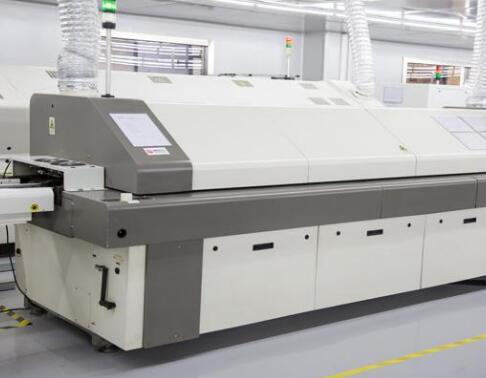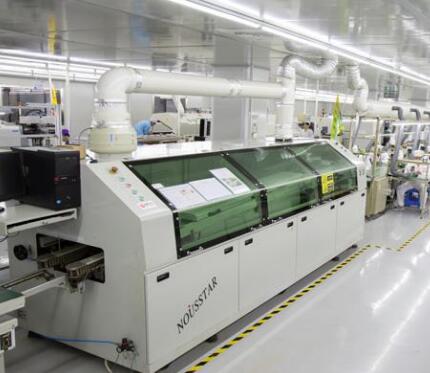Wave soldering and reflow soldering are two kinds of common electronic product welding methods in the electronic product production process. This article mainly introduces the difference between wave soldering and reflow soldering. First, the respective working principles of wave soldering and reflow soldering are introduced, followed by two The aspects of wave soldering and reflow soldering were analyzed.
Wave soldering IntroductionWave soldering refers to the melting of molten solder (lead-tin alloy), electrical pump or electromagnetic pump into the design requirements of the solder peak, can also be formed by injecting nitrogen into the solder pool, so that pre-installed components The printed board achieves the soldering of the mechanical and electrical connections between the component's soldered ends or the leads and the printed circuit board's solder bumps.
Wave soldering process: insert components into corresponding component holes → pre-coating flux → preheat (temperature 90-100°C, length 1-1.2m) → wave soldering (220-240°C) cooling → remove excess card foot → check .
Wave soldering worksWave soldering refers to the flow of molten solder (pb-Sn alloy) through an electric pump or an electromagnetic pump into a design-specific solder wave, so that the printed board pre-installed with components passes through the solder wave to achieve component soldering. Soldering of mechanical and electrical connections between terminals or pins and PCB pads. The wave soldering machine is mainly composed of a conveyor belt, a flux adding zone, a preheating zone and a wave soldering furnace.
The surface of the wave surface is covered with a layer of oxide skin. It remains almost static along the entire length of the solder wave. During the wave soldering process, the PCB contacts the front surface of the tin wave and the oxide scale breaks. The pleated land is pushed forward, which means that the entire scale moves at the same speed as the PCB. Wave solder joint formation: When the PCBA enters the front (A) of the wave front, the substrate and leads are heated and do not leave the wave front ( B) Before the whole PCB was immersed in solder, which was bridged by the solder, but at the instant of leaving the end of the wave, a small amount of solder adhered to the pad due to the wetting force, and due to the surface tension, There will be a small state of shrinkage centered on the lead, and the wetting force between the solder and the pad is greater than the cohesion of the solder between the two pads. As a result, full, round solder joints are formed, and excess solder leaving the wave tails falls back to the solder pot due to gravity.

Reflow technology is not new in the field of electronic manufacturing. The components on the various boards used in our computers are soldered to the circuit board through this process. Inside the device there is a heating circuit that blows air or nitrogen. Heat to a sufficiently high temperature and blow to the circuit board where the components have been attached. Allow the solder on both sides of the component to melt and bond with the motherboard. The advantage of this process is that the temperature is easy to control, oxidation can be avoided during the welding process, and manufacturing costs are also easier to control.
Reflow principleDue to the continuous miniaturization of electronic product PCB boards, there have been chip components, and traditional welding methods have been unable to meet the needs. Reflow soldering is used in the assembly of hybrid integrated circuit boards. The components for assembly and soldering are mostly chip capacitors, chip inductors, mount transistors, and two-tubes. With the development of the entire SMT technology and the emergence of a variety of chip components (SMCs) and placement devices (SMDs), the reflow process technology and equipment as part of the placement technology have also been correspondingly developed, and their applications have become increasingly widespread. Almost all electronic product domains have been applied.
Reflow is English. Reflow is achieved by re-melting paste solder pre-dispensed on PCB pads to achieve mechanical and electrical soldering of the surface-mounted component solder tails or pins to PCB lands. weld. Reflow soldering is the soldering of components to the PCB board, and the reflow soldering is to surface mount devices. Reflow is the effect of hot gas flow on the solder joints. Gel-like flux performs physical reaction under a constant high temperature airflow to achieve SMD soldering; so it is called “reflow soldering†because the gas circulates in the welder to generate high temperature for welding purposes. .

One difference:
The reflow process relies on remelting the paste solder pre-dispensed on the PCB pad to achieve soldering of the mechanically and electrically connected solder terminals of the surface-mount component or between the leads and the PCB pad.
Wave soldering has a new welding process with people's awareness of environmental protection. In the past, tin-lead alloys were used, but lead was a heavy metal that caused great harm to the human body. So now there is a lead process. It uses * tin silver copper alloy * and special flux and soldering temperature requirements of higher preheating temperature higher point to say that after the PCB board over the welding zone to set up a cooling area workstation. This is to prevent thermal shock. On the other hand, if there is ICT, it will have an impact on the detection.
The wave soldering can be solved basically. It solders to the relatively large and small components. This is different from reflow soldering. In reflow soldering, it heats the board and components. In fact, the solder paste that was brushed up is actually liquefied. In order to achieve the goal of connecting the components to the board.
1, reflow after preheating zone, recirculation zone, cooling zone. In addition, wave soldering is applicable to hand inserts and dispensing plates, and all components are required to be heat-resistant. Over-wave surfaces cannot have components that used to be SMT solder pastes. SMT solder paste plates can only be reflowed. Wave soldering.
2, wave soldering is through the tin tank will be dissolved into a liquid tin bar, the use of motor agitation wave formation, so that PCB and parts welded together, as used in the hand-insert welding and smt glue board. Reflow soldering is mainly used in the SMT industry. It conducts hot solder or other heat radiation to solder the solder paste printed on the PCB to the components.
3, different process: wave soldering flux to spray first, and then after preheating, welding, cooling area.
Different point two:
Wave soldering is mainly used for welding plug-in; reflow soldering is mainly for chip components
1, wave soldering is through the tin tank will be dissolved into a liquid tin bar, use the motor to form a wave agitated, so that PCB and parts welded together, as used in the hand-insert welding and SMT glue board. Reflow soldering is mainly used in the SMT industry. It conducts hot solder or other heat radiation to solder the solder paste printed on the PCB to the parts.
2, different process: wave soldering flux to spray first, and then after preheating, welding, cooling area. Reflow passes through the preheat zone, recirculation zone, and cooling zone. In addition, wave soldering is suitable for hand inserts and dispensing plates, and all components are required to be heat-resistant. Over-wave surfaces cannot have SMT solder paste components. SMT solder paste plates can only be reflowed. Wave soldering.
Replacement Bulb Lamp With Housing
Replacement Projector Lamp with housing has one more case than the bare bulb lamp, which can be directly put into the projector and more convenient than the installation of the bare bulblamp. The projection effect is the same as the compatible projector lamp, with stable light source and brightness, which can support daily life use
Replacement Bulb Lamp With Housing,Bulb Lamp,Dynamic Projector Lamp,Led Projector Lamp
Shenzhen Happybate Trading Co.,LTD , https://www.happybateprojector.com